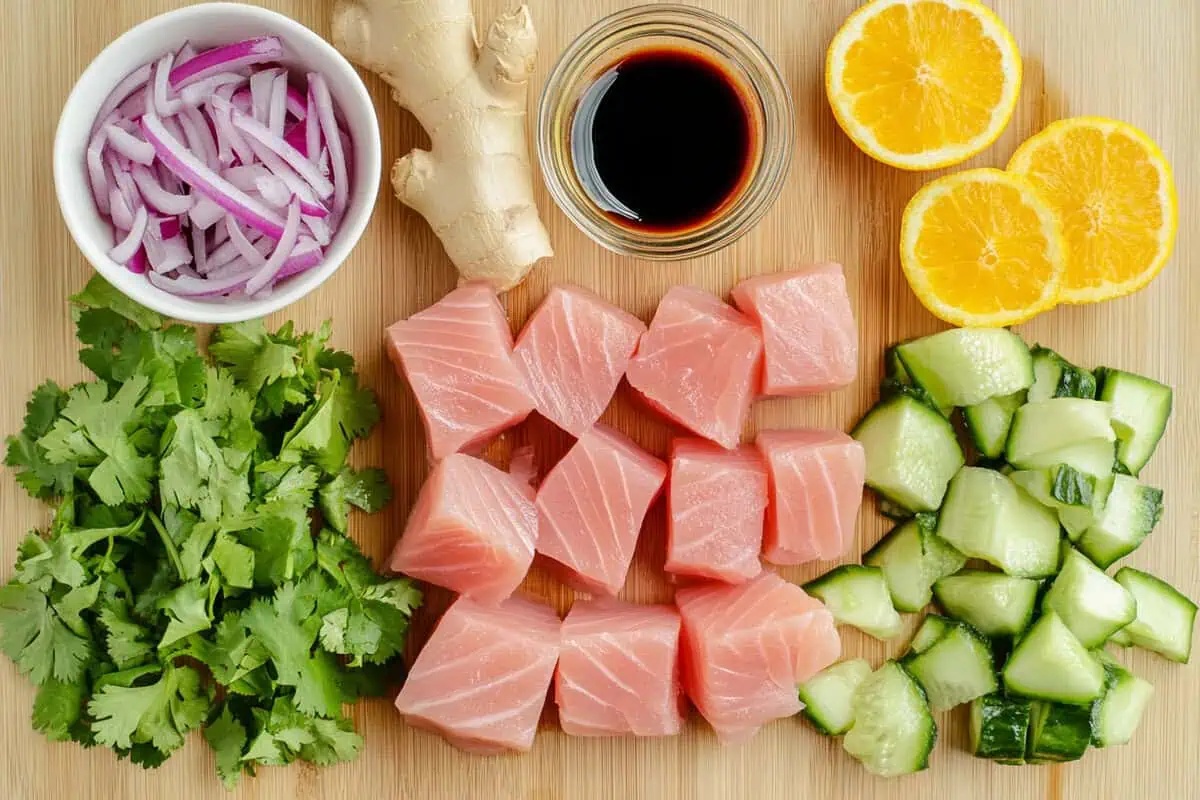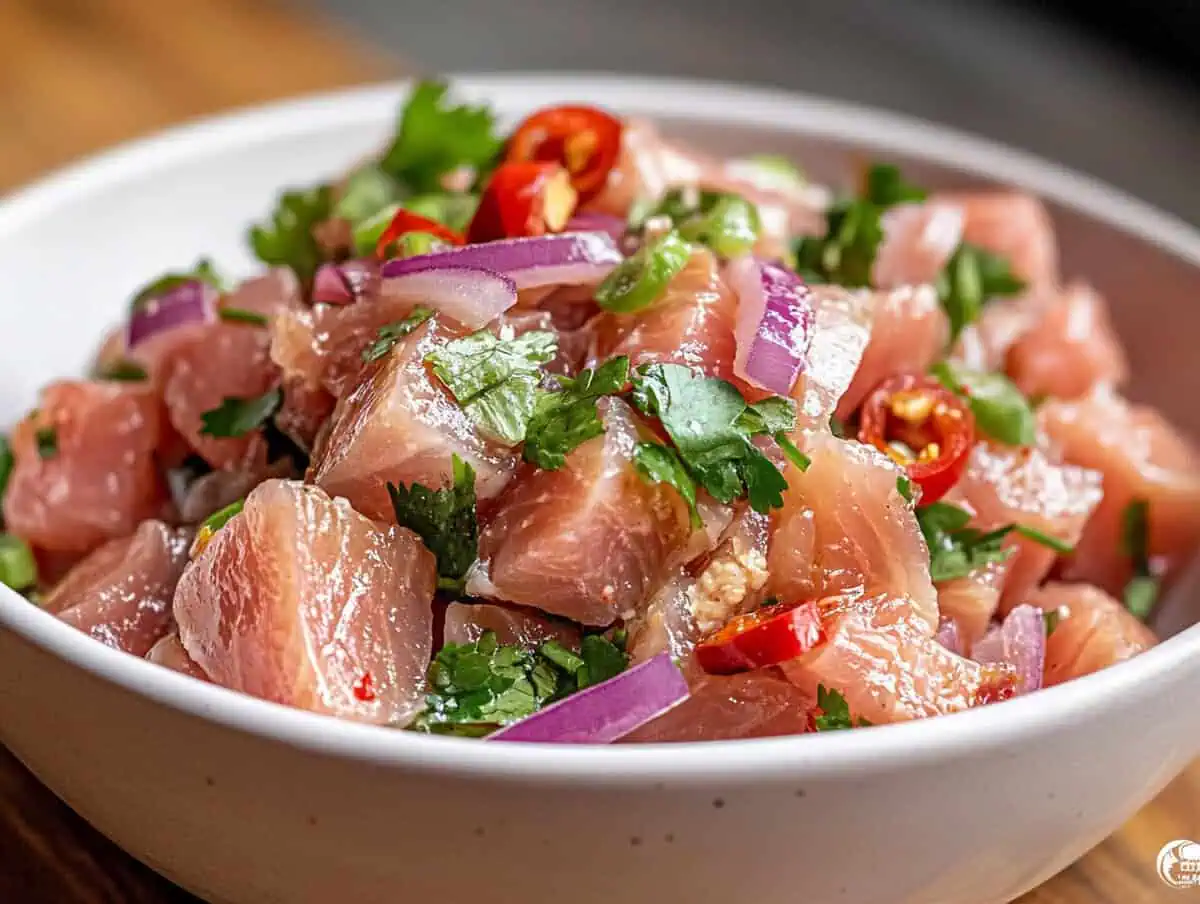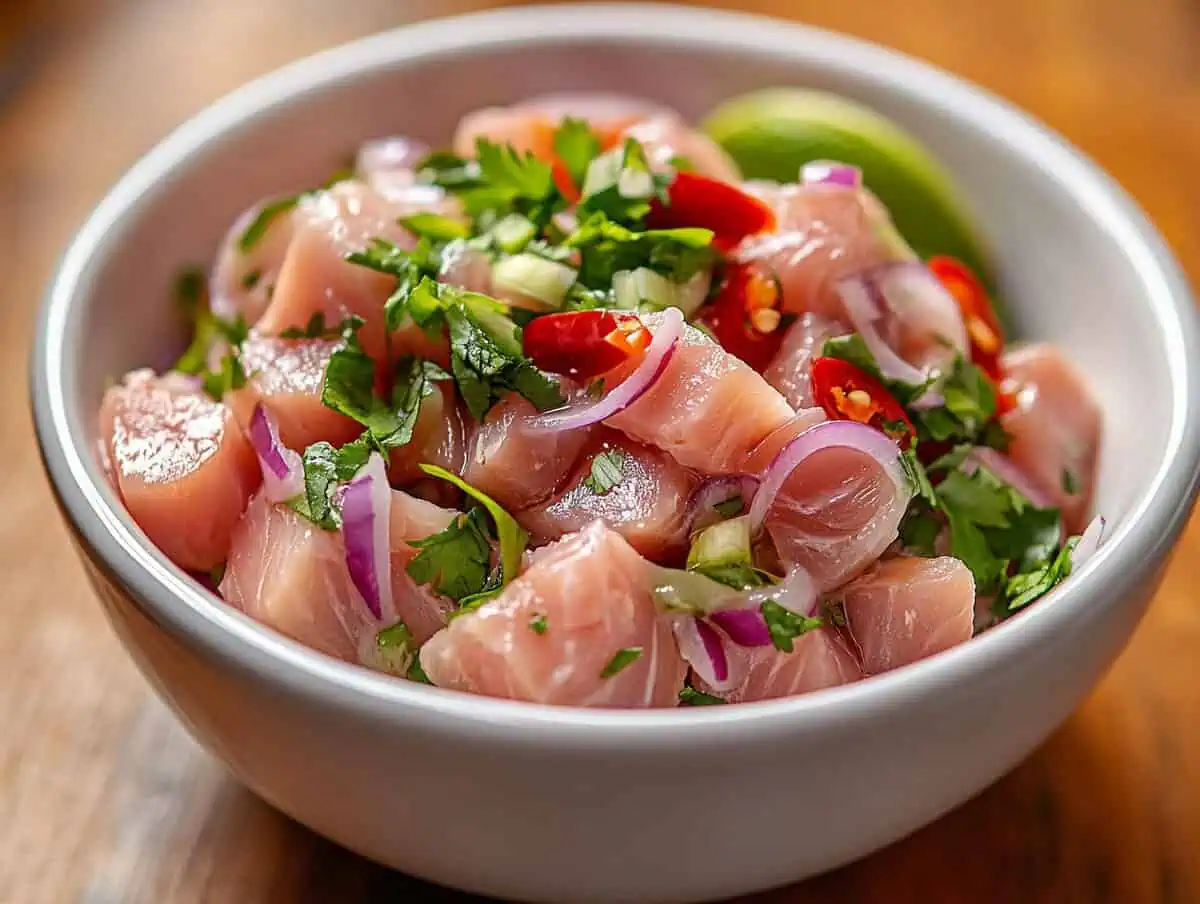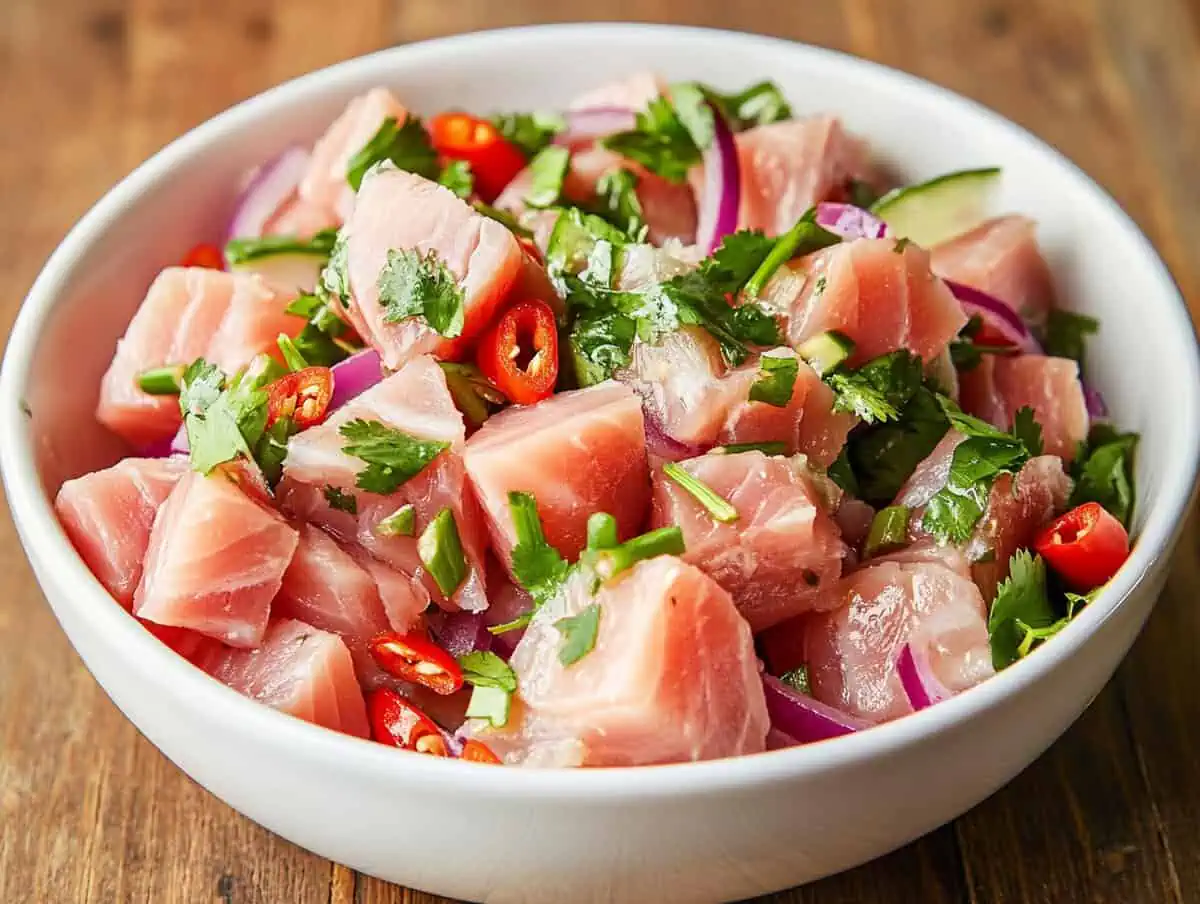This Kinilaw na Tuna has become my absolute favorite way to enjoy fresh seafood! If you've never tried this Filipino-style ceviche before, you're in for a treat. I discovered this recipe during my travels and have perfected it at home over the years.
Tender chunks of high-quality tuna are gently "cooked" in a vibrant mixture of vinegar and calamansi juice, then enhanced with aromatic ginger, crisp red onions, and just the right amount of chili heat. The addition of coconut milk brings a subtle creaminess that balances the bright acidity perfectly.
What I love most about this dish is how refreshing and light it feels while still being incredibly flavorful and satisfying. It takes just 30 minutes to prepare, making it perfect for impromptu gatherings or a quick weeknight dinner that feels special.
What is Kinilaw?
Kinilaw is the Filipino cousin to Latin American ceviche. The term "kilaw" means to eat fresh, and this dish features raw ingredients that are transformed by acidic marinades rather than heat. The acids in vinegar and calamansi juice "cook" the fish through denaturation, breaking down and transforming the protein structure, resulting in firm, opaque exterior while maintaining a tender, translucent interior.
Jump to:
Why You'll Love This Recipe
If you're a fan of fresh, zesty seafood dishes, this Tuna Kinilaw will become your new favorite! This Filipino-style ceviche combines tender chunks of raw tuna "cooked" in a bright, acidic marinade for a refreshing appetizer or main dish.
The combination of tangy vinegar, citrusy calamansi, aromatic ginger, and just the right amount of heat creates an incredible flavor experience that's perfect for warm days or as a light, protein-rich meal.
Ingredients
I carefully selected these ingredients to create the perfect balance of flavors in this Tuna Kinilaw. The fresh tuna provides a clean, mild base that absorbs all the bright flavors around it. Coconut vinegar and calamansi juice work together to "cook" the fish while adding a distinctly Filipino tang that's impossible to resist.
Red onions and ginger bring sharpness and warmth, while the two types of chilies add varying levels of heat that wake up your taste buds. The quick vinegar wash for the tuna is my secret technique for removing any fishiness, resulting in the cleanest flavor.
Finally, a touch of coconut milk softens the acidity and ties everything together with a subtle tropical creaminess that makes this dish truly special.

- 2 small red onions, thinly sliced
- 2-inch knob of ginger, thinly sliced
- 2 siling haba (green chili), thinly sliced
- 2 siling labuyo (red chili), thinly sliced
- ¼ cup coconut vinegar
- 3 tablespoon calamansi juice
- 2 teaspoon patis or fish sauce
- 500g tuna fillet, preferably sashimi-grade or IQF, cubed
- 3 tablespoon white vinegar
- 3 tablespoon coconut milk
- 2 tablespoon cilantro, finely chopped
Equipment
- Large mixing bowl
- Medium bowl
- Cutting board
- Sharp knife
- Measuring cups and spoons

How To Make
- Make dressing: Combine red onions, ginger, chilies, coconut vinegar, calamansi juice, and patis in a large bowl. Stir together and set aside for about 10 minutes to mellow the sharpness of the aromatics.
- "Wash" fish: In a separate bowl, "wash" your tuna by pouring the white vinegar over the fish and tossing it with your hands. Once evenly coated, discard the vinegar and any juices that have pooled at the bottom. This step removes fishiness in the raw tuna, resulting in a cleaner flavor. You'll notice the fish slowly turning from bright red to a pale pink as the vinegar begins to "cook" the tuna.
- Dress and serve: Toss the tuna cubes in the coconut vinegar mixture. Add coconut milk, then toss again until the fish is evenly coated. Garnish with cilantro and serve within 5–10 minutes, while the kinilaw is at peak freshness.

Tips from Lola's Kitchen
- For the best flavor, use the freshest tuna you can find.
- Slicing onions and ginger paper-thin helps their flavors infuse into the dish without overpowering it.
- The initial "washing" of the fish in white vinegar is crucial—don't skip this step as it significantly improves the final flavor.
- Serve kinilaw cold for the most refreshing experience.
- For a prettier presentation, reserve some of the thinly sliced chilies and cilantro for garnish.
Substitutions
- Fish options: While tuna is traditional, you can use other firm fish like bangus (milkfish), tanigue (Spanish mackerel), salmon, or regular mackerel.
- Calamansi substitute: If you can't find calamansi, use a mix of lime and mandarin orange juice (2:1 ratio).
- Coconut vinegar alternative: White vinegar or apple cider vinegar work well as substitutes.
- Chilies: Adjust the amount and type according to your heat preference. Jalapeños can substitute for siling haba, and bird's eye chilies for siling labuyo.
Troubleshooting
- Fish turns too "cooked" or rubbery: You likely marinated it too long. Remember that 5-15 minutes is ideal, and never go beyond 2 hours.
- Too sour: Balance with a tiny bit more coconut milk or a pinch of sugar.
- Too spicy: Add more coconut milk to temper the heat.
- Fish smells "fishy": This indicates the fish wasn't fresh enough. Always use sashimi-grade or high-quality fish for raw preparations.
Storage & Reheating
- Best practice: Kinilaw is meant to be enjoyed fresh and doesn't store well. For the best experience, consume within 1-2 hours of preparation.
- Short-term storage: If necessary, you can refrigerate leftovers for up to 24 hours in an airtight container, but the texture will continue to change as the acid "cooks" the fish.
- Not recommended: Freezing or reheating kinilaw is not recommended as it will completely change the texture and flavor profile of the dish.

FAQ
How does vinegar and calamansi juice "cook" the fish?
The acids in vinegar and calamansi juice break down and transform the protein structure in raw fish through a process called denaturation—the same thing that happens when you cook fish with heat. The fish gets firmer and less translucent, but unlike heat cooking, the inside stays somewhat raw and tender, creating that soft, sashimi-like texture.
How long should I soak the fish?
5–15 minutes is ideal for the best freshness and texture. If you prefer your kinilaw more "cooked," you can marinate it for up to 30 minutes to 1 hour maximum. Remember that the longer your fish soaks in acid, the mushier it becomes, so never let it sit past 2 hours.
What types of fish can I use for kinilaw?
Any firm fish like bangus (milkfish), tanigue (Spanish mackerel), salmon, and regular mackerel work well. For safety when eating raw, use sashimi/sushi-grade fish or IQF (Individually Quick Frozen) fish, which is cleaned and flash-frozen immediately after catching to seal in freshness and eliminate potential parasites.
Is kinilaw safe to eat?
When prepared with high-quality, properly handled fish, kinilaw is safe to eat. The acid in the marinade helps kill some bacteria, but it doesn't eliminate all potential pathogens. That's why it's essential to use sashimi-grade or IQF fish that's been properly frozen to kill parasites.
How do I serve kinilaw?
Serve kinilaw as a refreshing appetizer, alongside grilled meats, or over coconut rice for a poke bowl-style meal. It's traditionally enjoyed cold and fresh, making it perfect for warm weather dining.
Related
Looking for other recipes like this? Try these:

Kinilaw na Tuna (Filipino Ceviche Recipe)
Ingredients
- 2 small red onions thinly sliced
- 2- inch knob of ginger thinly sliced
- 2 siling haba green chili, thinly sliced
- 2 siling labuyo red chili, thinly sliced
- ¼ cup coconut vinegar
- 3 tablespoon calamansi juice
- 2 teaspoon patis or fish sauce
- 500 g tuna fillet preferably sashimi-grade or IQF, cubed
- 3 tablespoon white vinegar
- 3 tablespoon coconut milk
- 2 tablespoon cilantro finely chopped
Instructions
- Make dressing: Combine red onions, ginger, chilies, coconut vinegar, calamansi juice, and patis in a large bowl. Stir together and set aside for about 10 minutes to mellow the sharpness of the aromatics.
- "Wash" fish: In a separate bowl, "wash" your tuna by pouring the white vinegar over the fish and tossing it with your hands. Once evenly coated, discard the vinegar and any juices that have pooled at the bottom. This step removes fishiness in the raw tuna, resulting in a cleaner flavor. You'll notice the fish slowly turning from bright red to a pale pink as the vinegar begins to "cook" the tuna.
- Dress and serve: Toss the tuna cubes in the coconut vinegar mixture. Add coconut milk, then toss again until the fish is evenly coated. Garnish with cilantro and serve within 5–10 minutes, while the kinilaw is at peak freshness.
Tips from Lola's Kitchen
- For the best flavor, use the freshest tuna you can find.
- Slicing onions and ginger paper-thin helps their flavors infuse into the dish without overpowering it.
- The initial "washing" of the fish in white vinegar is crucial—don't skip this step as it significantly improves the final flavor.
- Serve kinilaw cold for the most refreshing experience.
- For a prettier presentation, reserve some of the thinly sliced chilies and cilantro for garnish.
The Story Behind Kinilaw na Tuna
Tuna Kinilaw has deep roots in Philippine culinary history, dating back centuries before Spanish colonization. The term "kilaw" literally means "eaten fresh" or "eaten raw" in Filipino languages, highlighting the dish's connection to the archipelago's abundant coastal resources.
Long before refrigeration existed, coastal communities across the Philippines developed kinilaw as a practical method of preparing and enjoying the day's fresh catch. Fishermen would prepare their catch right on their boats, cutting the freshest fish into bite-sized pieces and dousing them in vinegar, citrus, and local spices. This not only preserved the fish longer in the tropical heat but also created a delicious meal that celebrated the ocean's bounty.
What makes kinilaw uniquely Filipino is its ingenious use of native ingredients. While similar to Latin American ceviche, kinilaw typically incorporates distinctly Filipino elements like coconut vinegar, calamansi (Philippine lime), and sometimes coconut milk, creating a flavor profile that's unmistakably from the islands. The addition of coconut milk, in particular, distinguishes Filipino kinilaw from other raw fish preparations around the world, adding a subtle creaminess that balances the dish's acidity.
In the Philippines, kinilaw isn't just food—it's a celebration of place and community. It's commonly served as pulutan (finger food accompanying drinks) during gatherings and celebrations, bringing people together over fresh, vibrant flavors. Each region has its own variation, reflecting local ingredients and preferences, from the coconut-heavy versions of the Visayas to the spicier preparations found in Mindanao.
Today, tuna kinilaw has gained popularity beyond Philippine shores as global interest in Filipino cuisine continues to grow. Chefs worldwide are discovering the bright, balanced flavors of this traditional dish, often highlighting it as a prime example of the Philippines' sophisticated approach to seafood. Whether enjoyed on a beachfront in Cebu or at a modern Filipino restaurant in New York, tuna kinilaw connects diners to centuries of Filipino culinary wisdom and the country's deep relationship with the sea.










Comments
No Comments